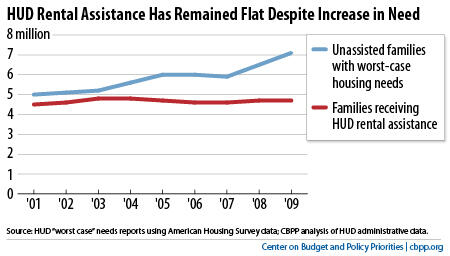BEYOND THE NUMBERS
The Need to Rebalance Federal Housing Policy, Part 3: Current Policies Don’t Keep Up
Yesterday’s installment of this blog series described how housing affordability has worsened for renters. Today, we look at how rental assistance can benefit low-income households — and how current rental assistance programs reach only a fraction of families in need.
The negative outcomes associated with poverty are well established. Research shows that childhood poverty has an especially long reach, dampening educational success and even earnings in adulthood.
But the research also shows that housing assistance is highly effective in fighting some of poverty’s worst effects. For example, it sharply reduces homelessness and housing instability — conditions that hurt children’s long-term health and development. Families that receive help paying their rent can free up other dollars for food, clothing, medications, child care, and transportation, and they may be able to save or invest in education.
Among the other pluses associated with housing assistance: work-promoting initiatives are more effective; the elderly and disabled can avoid or delay entering institutional care facilities; and school performance can improve when children have stable housing near strong schools. Moreover, health outcomes improve when recipients use vouchers to move to safer and less-poor neighborhoods.
Despite the long list of benefits, rental assistance — such as Section 8 housing vouchers — remains hard to come by. Just one in four eligible low-income families receives it due to limited funding for the existing programs. Large numbers of families who need help affording housing go without assistance in every state, as our recent analysis shows.
This shortfall has increased significantly in the last decade. The number of families struggling to afford rental costs has grown, but those receiving rental assistance has not kept pace (see chart).

It’s important that Congress provide adequate funding to maintain the number of families that the existing rental assistance programs assist, as we’ve recently explained. It’s unlikely, though, that those programs will expand enough in the near future to address the unmet need.
A federal renters’ tax credit could help meet some of this need, as we explained in our recently released paper. Tomorrow, we’ll discuss how such a credit would achieve this goal.
